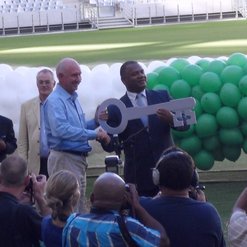By Duncan Mackay
December 15 – South Africa’s Green Point Stadium, which has been chosen to host a 2010 World Cup semi-final and where England will play Algeria on June 18, has been declared complete and the keys handed over to the Mayor of Cape Town.
The 68,000-seater stadium boosts the views of the iconic Table Mountain and the historic Robin Island, where Nelson Mandela was incarcerated.
Cape Town’s Mayor Dan Plato said: ”This has been worth the wait.
“Cape Town stadium will become one of the world’s sporting landmarks.”
But its 32-months construction process was dogged by labour strikes and faced fierce opposition from environmentalists who claimed that its existence would spoil the city landscape.
Green Point cost R4.5 billion rand (£371 million) and is one of ten venues that will be used during tournament.
En-wrapped by a façade of woven fibreglass, coated with Teflon, the stadium will resemble a rose-coloured bowl floating on a base, when lit up at night.
The architects have dubbed the stadium “the Diva of Cape Town”, reflecting the constantly changing moods of the city in varying weather conditions.
The design and construction of the roof is unique throughout the world.
Its basic structure resembled a bicycle wheel, open in the middle.
Some 72 cables linking the outer and inner rings of the circle were slowly tightened to raise the roof from ground level to its present height.
Another first for the roof is the use of 16 millimetre thick panels of glass to cover and protect the spectators from strong winds and rain.
This will let in the light while the ceiling panels underneath – made of woven PVC fabric – will soften the noise from within.
For the eight World Cup matches to be played at the venue, the stadium will have a seating capacity of 68,000, including 13,000 temporary seats which will be removed afterwards.

Features of the stadium are that it can be evacuated in 15 minutes and that all the spectators are close to the game.
Spectators will be protected by a state-of-the-art camera surveillance system which is monitored by police in the Venue Operations Centre inside the stadium, while pitch invasions are discouraged by a wide moat around the circumference.
There is also a police station inside the building to deal with hooligans and other criminals.
Other stadiums already completed include, Moses Mabhida in Durban and Soccer City in Johannesburg.
After the World Cup Green Point will be managed by French company Stade de France and used for rugby and football matches, concerts and religious gatherings.
Plato said it was a “stadium for all Capetonians”.
He said: “The stadium is ready for the world.”
Contact the writer of this story at zib.l1745066057labto1745066057ofdlr1745066057owedi1745066057sni@y1745066057akcam1745066057.nacn1745066057ud1745066057.
Related stories
November 2009: Durban opening turns into damp squib but officials still delighted
November 2009: Spectacular Durban World Cup stadium set to open

